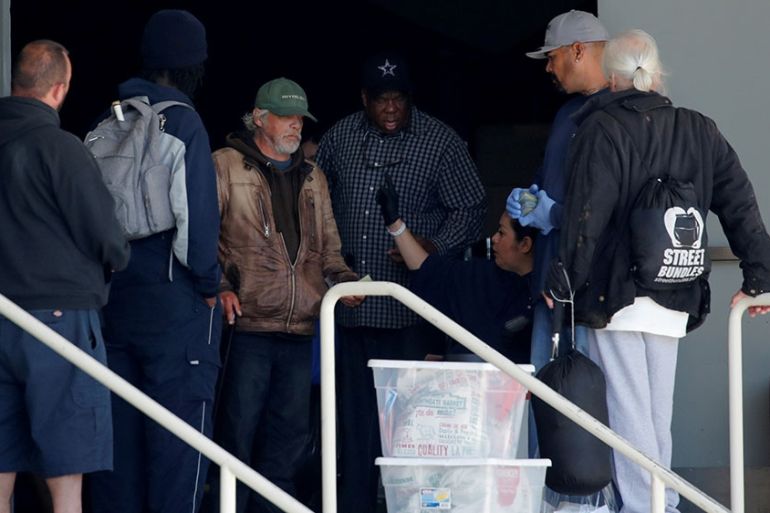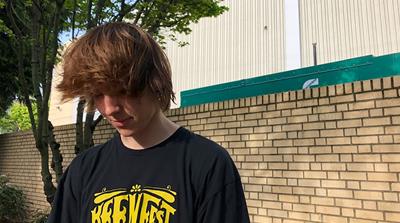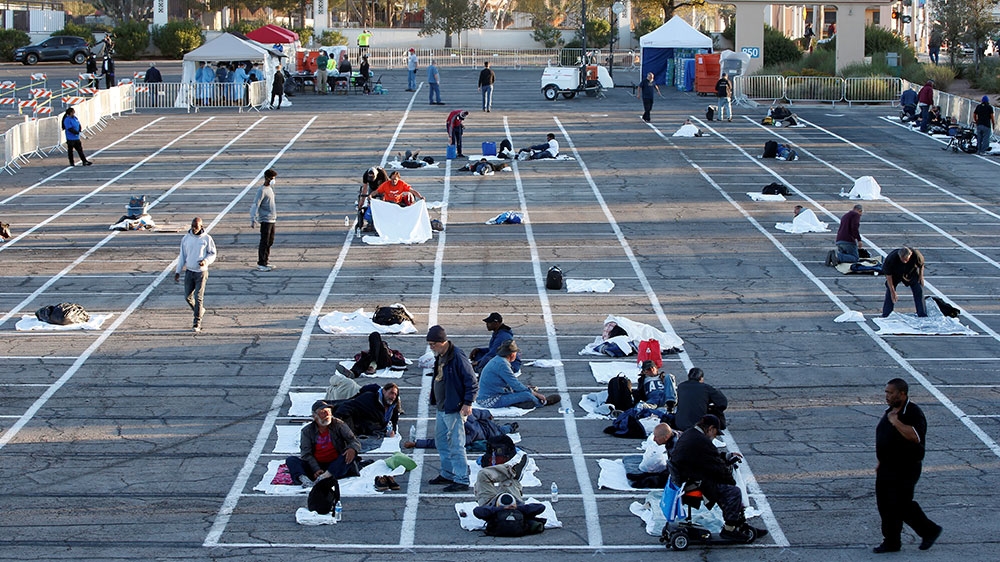Inside the US’s coronavirus convention-centre homeless shelters
The centres were converted into shelters to help stem COVID-19’s spread, but experts worry they may pose more of a risk.

Portland, Oregon – Outside the Oregon Convention Center (OCC) in downtown Portland, Oregon, sits a mobile shower with a wheelchair lift and a smoking shelter in which the massive building’s new, temporary residents sit shoulder-to-shoulder.
Inside, people pass the hours, sitting or lying in numbered, military-style green cots, in a shared central sleeping area divided by tape and hanging blue curtains. Residents say there is an eating area, large folding tables, chairs tipped up to show they have been sanitised and a single TV, whose remote control, a resident said, is kept by staff. No guests are allowed inside; coloured adhesive bracelets are checked at the front door. Officials at OCC declined Al Jazeera’s request for a tour.
Keep reading
list of 4 itemsMexico’s teachers seek relief from pandemic-era spike in school robberies
‘A bad chapter’: Tracing the origins of Ecuador’s rise in gang violence
Why is the US economy so resilient?
“The vibes are pretty good for the most part,” said 19-year-old OCC resident Logan Staggs. “They provide everything you need.”
There is one detail that Staggs dislikes, however: the star-like constellations of tiny LED lights in the ceilings.
“When I first went in there, the lights creeped me out,” Staggs said. “There’s no windows, so it can mess with your body clock.”

For residents the convention-centre homeless shelters that have popped up across the United States since the coronavirus hit, those lights can symbolise the cavernous scale and surreal nature of their surroundings – unprecedented, unforeseeable, and brought by a pandemic.
“It’s just a jillion lights,” said Kathleen Mortensen, 62, in San Diego Convention Center (SDCC). “There is a resemblance to stars.”
Warif Rahemtulla, 60, who is staying in the Fort Worth Convention Center (FWCC), said the lights help him relax. “It’s like looking at the sky,” Rahemtulla added. “If I can’t sleep, I look up, and I’m like wow, man. It’s pretty cool.”
As the impact of the coronavirus grew severe in March, convention centres axed programming and events that would have brought in billions of dollars. Homeless shelters also began to close as they could not meet social distancing guidelines. Homeless service systems, working with public health authorities, hoped that refurbishing the convention facilities into “non-congregate” shelters would allow for greater physical distancing. Around the country, they moved thousands of people into an unknown number of shelters in convention centres, many of them buildings with glimmering glasswork and stunning grounds. While authorities say the approach marked their best option for minimising COVID-19’s effects on the homeless population, critics fear that such massive undertakings may instead put them in the coronavirus’s crosshairs.
Shelter referrals
The Federal Emergency Management Authority (FEMA) has received requests from 31 states and one Indigenous tribe for a total $1.2bn in funds for “for eligible activities including but not limited to non-congregate sheltering”, the agency said.
FEMA told Al Jazeera the funds are for “health- and medical-related needs” and “may include” unhoused individuals, but the agency would not say how the $1.2bn was specifically allocated.
It is not clear how many of these shelters sit inside convention centres. FEMA “does not track” the number or locations of homeless shelters it is funding inside convention centres, a spokesperson said. FEMA referred Al Jazeera to the Housing and Urban Development agency, which did not respond to requests for comment.
More than 800 homeless people are sheltered in the San Diego Convention Center, and up to 1,500 may shelter there during the outbreak. https://t.co/ejlb2xK0w5 pic.twitter.com/vJoMi8FC54
— Gary Warth (@GaryWarthUT) April 8, 2020
The convention centre in San Diego alone holds 1,135 and is growing, while about 328 people on average sleep in the FWCC and 120 in Oregon.
Many of the “federal medical sites” for coronavirus could also be understood as de facto homeless shelters.
Inside Boston’s convention centre, at the Boston Hope medical centre for people recovering from COVID-19, more than half, or 97, of its 187 patients are homeless, according to Chief of Health and Human Services Marty Martinez.
The vast majority of those living in the convention centres are referrals from existing shelters, though some shelters, such as SDCC, later opened their doors to unsheltered homeless people. All of the centres require health screenings at intake. Residents must wear adhesive wristbands and are allowed to leave.
In turn, residents are provided with catered food, according to nearly a dozen residents who spoke to Al Jazeera from the San Diego, Portland and Fort Worth convention-centre shelters.
“The food can’t be beat,” David, a 70-year-old resident of the OCC shelter who declined to give his surname, told Al Jazeera. “I haven’t eaten this good for f****** decades.”
Public health concerns
Little is easy in these shelters, however. Authorities used the Las Vegas, Nevada, convention centre’s car park to give “shelter”. In Cincinnati, Ohio, pink yoga mats were used as beds. In Oregon, Texas and California, residents sleep in facilities that can cover 14 city blocks.
“This is all new and somewhat strange,” said Denis Theriault, spokesman for the OCC. A site lead and recently hired former data analyst there, Peter Tiso, said, “we’ve been learning a lot.”
Public health experts have expressed concern over the convention centre shelters. Dr Margot Kushel, director of the University of California San Francisco centre for Vulnerable Populations, said the idea these shelters prevent infections is “magical thinking”.
“You’re sharing bathrooms,” Kushel told Al Jazeera. “You can’t keep people six feet (1.8 metres) away.”

Eric Tars, legal director at the National Law Center on Homelessness and Poverty, agreed.
“Every one of these facilities is on its face violating the CDC’s guidance to avoid large gatherings,” he said.
The homeless population has a high incidence of what medical professionals call “comorbidities”: risk factors such as existing serious health problems, mental health struggles or addictions that make them particularly vulnerable, experts say.
Svenn-Erik Mamelund, a public health expert in Norway, said socioeconomic status has long been overlooked in public health responses. His study of deaths in the 1918-1919 influenza pandemic found “the first wave hits the poor, the second wave hits the rich.”
“I’m really, really concerned that in the end, it will be the poorest sections of society that will pay the highest burden from [coronavirus] mortality, as we have seen back in history,” Mamelund said.
SDCC recently saw its first two positive COVID-19 tests, while FWCC has had five, but currently has none. At OCC, county officials declined to share numbers. None has had outbreaks, but there have been outbreaks in some homeless shelters, including one in the Seattle area erected to decrease crowding.
In Portland, David said, coughing is “out of control”.
OCC shelter spokesman Theriault said that residents are referred to motels for isolation if they have a “new,” “worsening,” or “different” cough.
While the centres are not ideal, public health experts concede there is no simple solution.
“It’s almost impossible to manage the crisis of homelessness in a pandemic,” Kushel said.
Best option?
In the convention centre shelters, local officials contend that the facilities are the best option given the circumstances.
“They were already in our shelters, so we had to take quick action to make sure the physical distancing was being met,” said Ashley Bailey, a San Diego city spokesperson. “So, the convention centre is the best option.”
Officials have set up handwashing stations and mobile showers, hired staff, added screening procedures, transportation to hotels, and isolation programmes. They said they have been doing the best they can to keep vulnerable people – and the entire population – safe.
“This is what they’re used to,” said Richard Zavala, director of Parks and Rec at the City of Fort Worth, in charge of the FWCC shelter. “We’re only temporary, we’re not going to operate on a permanent basis. We don’t want to institutionalise it.”
Theriault said “the best public health practice would be for people to have homes” and “anything else we come up with is our best harm reduction approach.”
![Convention centers US - homeless [Thacher Schmid/Al Jazeera]](/wp-content/uploads/2020/05/234eaab5b6e34a2fb723475fe380689a_18.jpeg)
Federal housing officials agree, saying “private individual rooms” are the preferred pandemic homeless sheltering approach, while “shared spaces” are the least ideal.
In Fort Worth, 39 RV-housed individuals who have tested positive for COVID-19; 10 RVs provide isolation. In Portland, 17 people are in two hotel isolation programmes. San Diego is offering hotel rooms to some, Bailey says, “but that setting is not ideal for everyone.”
Zavala draws his experience from managing hurricane shelters, he said. Whereas SDCC and OCC residents can stay all day, Zavala’s gets residents up, feeds them breakfast burritos and gets them outside by 7am. They can return at 4pm.
There are other differences. In Portland, couples can push cots together; FWCC and SDCC separate genders. Four months pregnant, Lori Pena left bed 126 in San Diego because she was not allowed to be near her boyfriend.
“I want to protect my pregnancy,” Pena, 34, said. “We’re trying the best we can right now to stay together and keep our little family safe.”
It is not clear how long these convention-centre shelters will be open. Traditional shelters are often closely spaced, and cannot return to capacity until social distancing guidelines are no longer in place. “It’s the local and state health departments that are really running the show,” the University of California San Francisco’s Dr Kushel said.
In Texas, the first phase of the governor’s reopening plan took effect on Friday. Zavala estimates the Fort Worth centre’s shelter will be open another month or two.
“All depends on governor orders, moreover pandemic trends and health professionals,” he said.
It also may depend on the biggest unknown of all: the 30 million newly unemployed Americans. How many will lose their housing, and how much could the current figure of a half-million homeless grow, especially in cities and states already facing affordable housing crises?
Despite challenges and remaining questions, officials are upbeat, and residents have also found cause for gratitude.
In San Diego, Mortensen said, fresh laundry is placed in plastic bags on cots by 2pm daily, and “they don’t lose a sock.” In Portland, “we all just kind of support each other,” said Rubin, 23, declining to give a surname.
“This [pandemic] is the worst experience of my life. I’m going through hell, really,” said Rahemtulla, who is employed and has plans to get back into housing. “If it wasn’t for the convention centre, I don’t know what I’d do.”